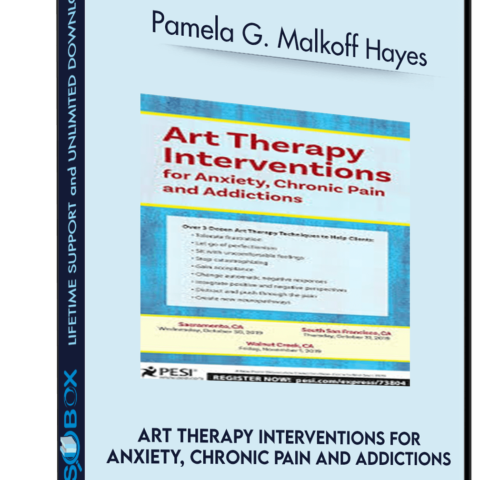ACT in practice 2022 – Steven C.Hayes
$184.00
ACT in practice 2022 – Steven C.Hayes… Gain practical tools for applying ACT from Dr. Steven C. Hayes through 10 online modules featuring extensive demonstration videos, network diagramming, clinical analysis, treatment planning, reads skills practice, and more.
Description
Purchase ACT in practice 2022 – Steven C.Hayes Course at eBokly. We actively participate in group buys and are committed to sharing knowledge with a wider audience. What's more, our courses maintain the same quality as the original sale page. You have the option to buy directly from the sale page at the full price (sale page link is provided within the post).
ACT in practice 2022 – Steven C.Hayes
Lifetime Access
Course enrollment comes with lifetime access to all course materials, plus you’ll be protected by a 14-Day Money-Back Guarantee.
Confidently Apply ACT from Intake through Treatment
Create a guiding framework for effectively using
acceptance and commitment therapy to cultivate lasting change
The Gap between Theory and Practice
- They work comfortably with acceptance and defusion, but struggle to find the right exercise to target self-as-context, so avoid it in sessions
- They sometimes feel like teachers instead of therapists, relying on lecturing to introduce concepts instead of weaving experiential exercises naturally into sessions
- They feel stuck when it comes to challenging clients, unsure of how to move forward or make their sessions as valuable as possible
- They hesitate to push certain clients to engage with difficult thoughts or feelings for fear of demotivating them further, but end up on different pages about their therapeutic aims
- They approach sessions with rigid ideas about what should happen next rather than being able to respond flexibly to the moment
Experiences like these are surprisingly common among ACT practitioners.Even skilled clinicians can feel uncertain when tailoring treatments for particularly difficult clients — especially without resorting to cookie-cutter interventions.But why is this the case, when we know the model and have seen it work?The answer goes beyond simply practicing more of the same, into something at the heart of this method.
How a Process-Based Framework Helps You Apply ACT More Effectively
1.It helps you think flexibly instead of linearly
2.It allows you to turn case complexity into opportunity
3. It provides a guiding pathway for work with lasting impact
Learning this Approach
I hope you’re starting to understand how this expanded process-based framework can help you ground ACT theory in practical application so you can implement it more creatively, confidently, and effectively. Seeing this framework in action and practicing it yourself is the best way to learn how to apply it in your own sessions.And that’s exactly what I’m about to share with you.Below are all of the details about my online course that builds on what you already know about ACT, teaches you practical tools for applying it, and shows you how to put them to work in sessions. Inside, we’re going to bring the philosophical visions of process-based therapy down to things like how to do an intake, how to do a different kind of diagnosis, how to do a functional analysis, how to design a treatment, and how to face other challenges presented in your daily work.Along the way, you’ll learn practical skills and tools to help you more effectively bring about positive change for your clients.
Course Format
Course Structure
Throughout the course, you will develop a guiding framework and practical skills that help you:
- Develop a deeper understanding of your clients from the very first session, so you can plan and implement treatment more effectively with holistic aims in mind
- Access a broad range of exercises, metaphors, and interventions that can help you create experiential learning in sessions rather than resorting to lecturing
- Hone your ability to make accurate reads and identify client strengths and weaknesses as well as opportunities for meaningful work
- Always have a full grasp of your client’s entire case and how issues are being retained, so you can move flexibly between processes and maintain a clear sense of direction
- Understand how to use the psychological flexibility model as a framework for incorporating other important processes and interventions in evidence-based therapy
Curriculum
Module 1: Preliminary Network
- How a process-based framework offers a better way forward than previous efforts to categorize and treat psychological disorders
- The guideposts you can follow throughout the client relationship to better understand someone’s case, choose interventions, and measure outcomes
- Start building the practical skills needed to visualize a client’s case clearly
- See Dr. Hayes’s thought process as he walks you through creating a preliminary network diagram for Mariana, a roleplay client dealing with a history of abuse and struggling to find joy and connection in life
- Draw your own preliminary network diagram based on a case study of Stan, a father experiencing debilitating anxiety that impacts his relationship with his family
Module 2: Functional Analysis
- How process-based functional analysis can help you choose treatment interventions that give you the greatest chance of success
- How to measure a client’s psychological flexibility, your therapeutic alliance with them, and treatment outcomes
- Using an Extended Evolutionary Meta Model to understand clients’ psychology in relation to physiological and social factors
- Watch Dr. Hayes perform functional analysis of Mariana’s case by building on his preliminary network diagram
- Take your preliminary network diagram of Stan’s case to the next stage: creating a functional analysis diagram
Module 3: Treatment Planning
- Turning functional analysis into an effective treatment plan that fits with a client’s goals for therapy
- How to disrupt maladaptive behavior patterns within a case and turn them into self-sustaining adaptive loops that will last even after your work with a client ends
- Review an emotional approach to creative hopelessness for Mariana, a strategy that can be used with clients who are resistant to change
- Watch as Dr. Hayes creates a treatment plan diagram for Mariana and shares his thought process
- Based on your functional analysis diagram from Module 2, draw a treatment planning diagram that helps you map out impactful interventions for Stan
Module 4: Acceptance and Defusion
- Identify reads and interventions related to emotional and cognitive flexibility (acceptance and defusion)
- How to target these two processes indirectly through other areas of psychological flexibility, and vice versa, opening up more options for meaningful intervention
- Watch a 3-part roleplay with Mariana showing key elements of the treatment plan created in Module 3
- Examples of how to successfully implement defusion and perspective-taking exercises, and how to repurpose pain into values-based action
Module 5: Present Moment and Self-As-Context
- Review psychological flexibility reads and interventions related to touching the “now” and sense of self
- How to move these processes indirectly through other corners of the hexagon in order to expand your flexibility during sessions
- View a 3-part roleplay with Sally, a client experiencing depressed mood as she flounders without a sense of purpose in retirement
- See Dr. Hayes taking a psychoeducational approach to creative hopelessness within the roleplay
- Examples of how to successfully implement present moment exercises and the “devil’s advocate” approach to clarifying values
Module 6: Values and Committed Action
- Identify reads and interventions related to values and committed action
- How interventions in these two areas can impact other core processes that support them, increasing your efficacy with clients
- Watch a 3-part roleplay with Stan, which includes a values approach to creative hopelessness
- See examples of how to successfully implement the “advisor” values exercise and an ACT-based exposure exercise to channel anxious energy into committed action
Module 7: Hexadancing
- How hexadancing works and why it can be a useful approach to implementing ACT
- See hexadancing used effectively in a real play session with a clinician who longs to connect more deeply with his wife and community
- Understand the importance of extending flexibility processes out socially, and see a demonstration of how it’s possible
- How ACT work fits into the larger arc of mindfulness, acceptance-based approaches, and contemplative practice
- Complete 3 exercises in which you’re presented with progressively more challenging statements from clients and must decide on appropriate ACT responses, which you can then compare with Dr. Hayes’s answers and explanations
Module 8: Practicing Reads Skills
- Participate in a classic training technique used by the original ACT founders in order to hone your ability to make accurate reads
- Boost your skills so you can quickly read psychological flexibility processes in the moment
- Watch a real play in which Dr. Hayes works with a woman experiencing excessive worry and difficulty staying in the present moment
- Practice reading a client’s psychological flexibility processes based on the real play transcript, and start identifying which processes Dr. Hayes is targeting and how
- Compare your work to Dr. Hayes’s and begin to understand your strengths and weaknesses at reading the psychological flexibility processes
- Learn from Dr. Hayes as he explains what he was observing and thinking during the example session
Module 9: Reads Skills Test
- Watch a real play in which Dr. Hayes works with a man who feels stuck when it comes to caring for his health
- Assess your skill in reading psychological flexibility processes, as well as discerning which processes Dr. Hayes is targeting, using the real play transcript
- Compare your answers to those of Dr. Hayes and Dr. Robyn Walser, another premier ACT expert, to help you objectively identify areas for improvement
- Learn from Dr. Hayes as he explains what he was observing and thinking during the example session
- Ultimately, become more proficient in making accurate reads so you can apply ACT more confidently and respond flexibly to what comes up in sessions
Module 10: Assessing ACT Interventions
- View a real play in which Dr. Hayes explores the connection between loss and love with a woman yearning for freer intimacy in her relationships
- Use a therapist rating scale to score interventions within the real play for their efficacy and how well they correspond with ACT principles
- Review written and audio commentary by three of the world’s leading ACT experts — Dr. Hayes, Dr. Robyn Walser, and Dr. Kelly Wilson — explaining why certain choices are (or are not) effective in a given context
- Hone your skill at judging the efficacy of ACT-appropriate moves, so you can finetune your own interventions and make a bigger impact as a practitioner
Included Resources
- ACT Assessment Toolkit – Dr. Hayes’s curated list of the simplest short clinical assessment tools, ready for downloading to use with clients
- Single-item Assessments – A list of single-item measures that you can download as a Google Doc and tailor to create individualized assessment questionnaires for clients
- Targeted Assessment Tools – A range of tools for specific client populations and issues (e.g., cancer, chronic pain, smoking, weight issues), ready for downloading to use with clients
- ACT Rating Scale Training Manual – A guide to using the objective scale for rating therapist efficacy developed by Dr. Robyn Walser and Varvara Mazina
Are you interested in? ACT in practice 2022 – Steven C.Hayes Download, act in practice, mental health act in practice, act in practice praxis, act in practice course, nurse practice act in florida.
Purchasing ACT in practice 2022 – Steven C.Hayes course now, You can get it with the LIFETIME SUPPORT and UNLIMITED DOWNLOAD.
Purchase the ACT in practice 2022 – Steven C.Hayes course at the best price at eBokly. Upon completing your purchase, you will gain access to the downloads page. where you can conveniently retrieve all associated course files. Additionally, we will send you a download notification email to your registered mail.
Unlock your full potential with our ACT in practice 2022 – Steven C.Hayes courses. Our courses are meticulously designed to empower you with the skills and knowledge needed for excellence.
Why wait? Take the first step towards greatness by acquiring our ACT in practice 2022 – Steven C.Hayes courses today. We ensure a smooth and secure purchasing experience that guarantees your peace of mind. Rest assured that your financial information is safeguarded through our trusted payment gateways, Stripe and PayPal.
Stripe, renowned for its robust security measures, offers a secure and dependable payment process. Your sensitive data is encrypted using state-of-the-art technology, ensuring its confidentiality throughout the transaction.
PayPal, a globally recognized payment platform, adds an extra layer of security. With its buyer protection program, you can make your purchase with confidence, knowing that your financial details are protected, allowing you to focus on your learning journey.
Is it secure? to Use of?
- Rest assured, your identity remains completely confidential. We do not share your information with anyone, ensuring the utmost security when you buy the ACT in practice 2022 – Steven C.Hayes course.
- 100% Safe Checkout Privateness coverage
- We employ robust communication and encryption methods to protect sensitive information. All card numbers are encrypted using AES at rest-256, and the transmission of card numbers occurs in a separate hosting environment, without sharing or storing any data.
How Will the Course Be Delivered?
- Upon successful payment for the “ACT in practice 2022 – Steven C.Hayes course”, Most of the products will come to you immediately. But for some products were posted for offer. Please wait for our response, it might take a few hours due to the time zone difference.
- If this occurs, kindly be patient. Our technical department will process the link shortly, and you will receive notifications directly via email. Your patience is greatly appreciated.
What Shipping Methods Are Available?
- You will receive a download link in the invoice or in YOUR ACCOUNT.
- The course link is always accessible. Simply log in to your account to download the ACT in practice 2022 – Steven C.Hayes course whenever you need.
- You can study online or download the content for better results, making it accessible from any device. Ensure your system does not go to sleep during the download process..
How Do I Track Order?
- We promptly update the status of your order following your payment. If, after 7 days, there is no download link provided, the system will automatically process a refund..
- We love to hear from you. Please don’t hesitate to email us with any comments, questions and suggestions.

 Purchase this course you will earn
Purchase this course you will earn 







